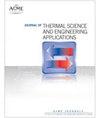多参数气膜冷却效率模型及数值研究
IF 1.4
4区 工程技术
Q3 ENGINEERING, MECHANICAL
引用次数: 0
摘要
摘要基于经过验证的气膜冷却模拟方法和多相流模拟方法,建立了前倾扇形气膜孔、不同喷射角度的圆柱形气膜孔和含水蒸气气膜孔的多级三维模拟,探讨了气膜孔结构参数、孔距、吹气比、喷射角度和水蒸气体积对气膜冷却效率的影响。前倾扇形膜孔的冷却效率随着膜孔出口长度的增加而增加。加入水蒸气后,扇形膜孔的冷却效率降低,孔轴长和出口长度对冷却效率的影响较弱。对于圆柱形膜孔,在相同吹气比下,膜孔注射角越大,膜覆盖面积越大。加入水蒸气后,随着吹气比的增大,膜覆盖面积先增大后减小。而对于含有水蒸气的膜孔,随着冷却喷射角度的增大,膜覆盖面积减小。有水蒸气和无水蒸气的膜孔冷却效率分别与上升方向的蒸汽速度和主流方向的蒸汽速度有关。根据主气流方向平均冷却效率随喷射角的正弦值呈指数增长的规律,建立了气膜冷却效率随吹气比和喷射角变化的模型,并用实验数据进行了验证。本文章由计算机程序翻译,如有差异,请以英文原文为准。
A Cooling Efficiency Model and Numerical Research of Multiparameter Film Cooling
Abstract Based on the validated simulation method of film cooling and multiphase flow simulation method, a multi-level three-dimensional simulation of forward-leaning fan-shaped film hole, cylindrical film hole with different injection angles, and film hole containing water vapor are established to discuss the effects of film hole structure parameters, hole distance, blowing ratio, injection angle, and water vapor volume on film cooling efficiency. The cooling efficiency of forward-leaning fan-shaped film hole increases as the exit length of film hole increases. After adding water vapor, the cooling efficiency of fan-shaped film hole decreases, and the influence of hole axis length and exit length on cooling efficiency is weak. For the cylindrical film hole, the larger the injection angle of film hole, the larger the film coverage area under the same blowing ratio. After adding water vapor, with the increase of the blowing ratio, the film coverage area increases first and then decreases. However, the film coverage area decreases with the increase of cooling injection angle for film holes containing water vapor. The cooling efficiency of the film hole with and without water vapor is related to the vapor velocity in the rising direction and the velocity in the mainstream direction, respectively. A model of film cooling efficiency with air blowing ratio and injection angle is established and verified with experimental data, based on the law that the average cooling efficiency in the main flow direction grows exponentially with the sine of the injection angle.
求助全文
通过发布文献求助,成功后即可免费获取论文全文。
去求助
来源期刊

Journal of Thermal Science and Engineering Applications
THERMODYNAMICSENGINEERING, MECHANICAL -ENGINEERING, MECHANICAL
CiteScore
3.60
自引率
9.50%
发文量
120
期刊介绍:
Applications in: Aerospace systems; Gas turbines; Biotechnology; Defense systems; Electronic and photonic equipment; Energy systems; Manufacturing; Refrigeration and air conditioning; Homeland security systems; Micro- and nanoscale devices; Petrochemical processing; Medical systems; Energy efficiency; Sustainability; Solar systems; Combustion systems
 求助内容:
求助内容: 应助结果提醒方式:
应助结果提醒方式:


